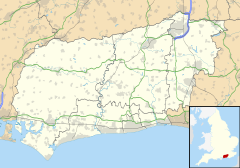Haywards Heath
| Haywards Heath | |
|---|---|
 Haywards Heath Town Hall |
|
| Haywards Heath shown within West Sussex | |
| Area | 9.75 km2 (3.76 sq mi) |
| Population | 22,800 2001 Census 27,057 (2011 Census) |
| • Density | 2,338/km2 (6,060/sq mi) |
| OS grid reference | TQ335245 |
| • London | 34 mi (55 km)N |
| Civil parish |
|
| District | |
| Shire county | |
| Region | |
| Country | England |
| Sovereign state | United Kingdom |
| Post town | HAYWARDS HEATH |
| Postcode district | RH16, RH17 |
| Dialling code | 01444 |
| Police | Sussex |
| Fire | West Sussex |
| Ambulance | South East Coast |
| EU Parliament | South East England |
| UK Parliament | |
| Website | Haywards Heath Town Council |
Haywards Heath is a town in the Mid Sussex District of West Sussex, within the historic county of Sussex, England. It lies 36 miles (58 km) south of London, 14 miles (23 km) north of Brighton, 13 miles (21 km) south of Gatwick Airport and 31 miles (50 km) east northeast of the county town of Chichester. Nearby towns include Burgess Hill to the southwest, Horsham to the northwest, Crawley north-northwest and East Grinstead north-northeast. Being a commuter town with only a relatively small number of jobs available in the immediate vicinity, mostly in the agricultural or service sector, many of the residents commute daily via road or rail to London, Brighton, Crawley or Gatwick for work.
The name Hayward comes from Old English meaning an official who protected hedged enclosures from wandering livestock. There is a local legend that the name comes from a highwayman who went under the name of Jack Hayward.
Haywards Heath gets a mention in English Civil War records. Early in December 1642 the High Sheriff of Sussex (Sir Edward Ford) advanced with Royalist troops towards Lewes in East Sussex from Chichester in West Sussex. He was intercepted in Haywards Heath by local Parliamentarians and defeated. Haywards Heath as a settlement is a relatively modern development. Following the arrival of the London & Brighton Railway in 1841, its size has increased considerably. Haywards Heath railway station opened on 12 July 1841 and served as the southern terminus of the line until the completion of Brighton station on 21 September. The position of Haywards Heath, and its place on both this railway and near the main road (A23) between London and Brighton, enables it to function as a commuter town, with many residents working in London, Brighton, Crawley and Gatwick Airport.
...
Wikipedia

